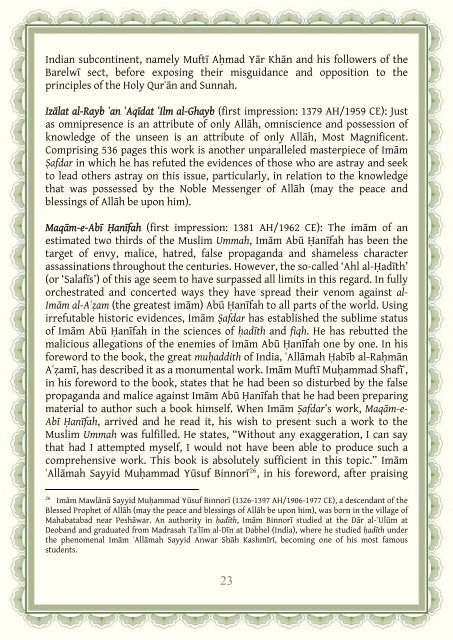Create successful ePaper yourself
Turn your PDF publications into a flip-book with our unique Google optimized e-Paper software.
Indian subcontinent, namely Muftī Aḥmad Yār Khān and his followers of the<br />
Barelwī sect, before exposing their misguidance and opposition to the<br />
principles of the Holy Qurʾān and Sunnah.<br />
Izālat al-Rayb ʿan ʿAqīdat ʿIlm al-Ghayb (first impression: 1379 AH/1959 CE): Just<br />
as omnipresence is an attribute of only Allāh, omniscience and possession of<br />
knowledge of the unseen is an attribute of only Allāh, Most Magnificent.<br />
Comprising 536 pages this work is another unparalleled masterpiece of Imām<br />
Ṣafdar in which he has refuted the evidences of those who are astray and seek<br />
to lead others astray on this issue, particularly, in relation to the knowledge<br />
that was possessed by the Noble Messenger of Allāh (may the peace and<br />
blessings of Allāh be upon him).<br />
Maqām-e-Abī Ḥanīfah (first impression: 1381 AH/1962 CE): The imām of an<br />
estimated two thirds of the Muslim Ummah, Imām Abū Ḥanīfah has been the<br />
target of envy, malice, hatred, false propaganda and shameless character<br />
assassinations throughout the centuries. However, the so-called ‘Ahl al-Ḥadīth’<br />
(or ‘Salafīs’) of this age seem to have surpassed all limits in this regard. In fully<br />
orchestrated and concerted ways they have spread their venom against al-<br />
Imām al-Aʿẓam (the greatest imām) Abū Ḥanīfah to all parts of the world. Using<br />
irrefutable historic evidences, Imām Ṣafdar has established the sublime status<br />
of Imām Abū Ḥanīfah in the sciences of ḥadīth and fiqh. He has rebutted the<br />
malicious allegations of the enemies of Imām Abū Ḥanīfah one by one. In his<br />
foreword to the book, the great muḥaddith of India, ʿAllāmah Ḥabīb al-Raḥmān<br />
Aʿẓamī, has described it as a monumental work. Imām Muftī Muḥammad Shafīʿ,<br />
in his foreword to the book, states that he had been so disturbed by the false<br />
propaganda and malice against Imām Abū Ḥanīfah that he had been preparing<br />
material to author such a book himself. When Imām Ṣafdar’s work, Maqām-e-<br />
Abī Ḥanīfah, arrived and he read it, his wish to present such a work to the<br />
Muslim Ummah was fulfilled. He states, “Without any exaggeration, I can say<br />
that had I attempted myself, I would not have been able to produce such a<br />
comprehensive work. This book is absolutely sufficient in this topic.” Imām<br />
ʿAllāmah Sayyid Muḥammad Yūsuf Binnorī 26 , in his foreword, after praising<br />
26<br />
Imām Mawlānā Sayyid Muḥammad Yūsuf Binnorī (1326-1397 AH/1906-1977 CE), a descendant of the<br />
Blessed Prophet of Allāh (may the peace and blessings of Allāh be upon him), was born in the village of<br />
Mahabatabad near Peshāwar. An authority in ḥadīth, Imām Binnorī studied at the Dār al-ʿUlūm at<br />
Deoband and graduated from Madrasah Taʿlīm al-Dīn at Dabhel (India), where he studied ḥadīth under<br />
the phenomenal Imām ʿAllāmah Sayyid Anwar Shāh Kashmīrī, becoming one of his most famous<br />
students.<br />
23














